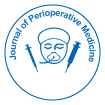
Journal of Perioperative Medicine
Open Access
ISSN: 2684-1290

ISSN: 2684-1290
Opinion Article - (2025)Volume 8, Issue 1
The perioperative management of patients with chronic pain who are on long-term opioid therapy presents one of the most complex challenges in modern anaesthesiology and surgical care. As the prevalence of chronic pain continues to rise in highincome countries, so does the number of patients presenting for surgery with baseline opioid dependence or tolerance. These patients are at increased risk for inadequate pain control, opioidrelated complications, prolonged hospital stays and poor postoperative outcomes. Yet, many surgical teams are still inadequately prepared to meet their unique perioperative needs.
One of the most significant challenges in managing this population is opioid tolerance. Patients on long-term opioids often have altered receptor sensitivity and require higher doses to achieve effective analgesia. Standard opioid regimens may be insufficient, leading to severe postoperative pain and patient dissatisfaction. This can drive uncontrolled dose escalation or "opioid stacking," which increases the risk of respiratory depression and sedation without necessarily improving analgesia. Furthermore, opioid-induced hyperalgesia a paradoxical response in which patients become more sensitive to pain can complicate postoperative pain control. This phenomenon challenges the conventional wisdom that simply increasing the opioid dose will improve pain relief and highlights the importance of incorporating non-opioid analgesics and interventional strategies.
Another key issue is the stigma and misunderstanding often encountered by patients on chronic opioid therapy. Some healthcare providers may question the legitimacy of their pain or suspect misuse, resulting in under treatment or adversarial dynamics. This undermines trust, increases anxiety and may lead to noncompliance or disengagement from care. Preoperative communication is therefore important. Patients should be assured that their pain will be managed proactively and respectfully, with a clear, personalized plan in place.
Multimodal analgesia is the cornerstone of effective perioperative management for this population. Combining non opioid medications such as acetaminophen, NSAIDs (when appropriate), gabapentinoids, NMDA antagonists like ketamine and regional anaesthesia techniques can help reduce the reliance on high-dose opioids. Preoperative planning should also involve reviewing and continuing the patient’s baseline opioid regimen to avoid withdrawal symptoms. Abrupt discontinuation or withholding of opioids can cause physiological stress, worsen pain perception and destabilize patients both physically and psychologically.
Preoperative consultation with a pain management team or anaesthesiologist trained in chronic pain can be extremely valuable. Such consultation allows for risk stratification, adjustment of existing opioid regimens and formulation of a comprehensive perioperative analgesia plan. It also provides an opportunity to identify patients who may benefit from opioid tapering, behavioural interventions, or referral to addiction specialists if concerns about misuse or dependence are present.
Regional anaesthesia and nerve blocks play a particularly important role in this context. Techniques such as continuous peripheral nerve catheters, epidural analgesia and neuraxial blocks can significantly reduce the need for systemic opioids and improve patient comfort. In some cases, intraoperative ketamine or lidocaine infusions can also provide analgesia and reduce postoperative opioid requirements.
In the postoperative period, patients on chronic opioids often require a longer titration period and a customised discharge plan. Effective transition to outpatient care, including communication with the patient’s primary care physician or pain specialist, is essential. Unfortunately, this handoff is frequently overlooked, increasing the risk of poor follow-up, uncontrolled pain, or misuse of prescribed medications.
High-income countries are uniquely positioned to lead the way in refining best practices for this complex population. With access to comprehensive electronic health records, interdisciplinary pain services and opioid stewardship programs, healthcare systems can build more cohesive and proactive perioperative pain management models. Institutions should also prioritize provider education to dispel misconceptions about chronic opioid therapy and emphasize patient-centred care principles.
Patients on long-term opioid therapy for chronic pain require nuanced and individualized perioperative management. Standard analgesic protocols are often insufficient for this population and failure to address their unique needs can result in suboptimal outcomes, increased complications and prolonged recovery.
A thoughtful, multidisciplinary approach grounded in multimodal analgesia, preoperative planning and compassionate care is essential to navigate the challenges of opioid tolerance, dependence and hyperalgesia. By investing in education, early pain consultation and coordinated postoperative care, high income healthcare systems can improve the safety, efficacy and dignity of perioperative pain management for chronic pain patients on long term opioids. These efforts are not only clinically necessary but ethically imperative in a healthcare environment committed to equity and patient centred outcomes.
Citation: Thompson RA (2025). Perioperative Management of Chronic Pain Patients on Long-Term Opioids. J Perioper Med. 8:267.
Received: 05-Feb-2025, Manuscript No. JPME-25-37977; Editor assigned: 07-Feb-2025, Pre QC No. JPME-25-37977 (PQ); Reviewed: 22-Feb-2025, QC No. JPME-25-37977; Revised: 02-Mar-2025, Manuscript No. JPME-25-37977 (R); Accepted: 09-Mar-2025 , DOI: 10.35248/2684-1290.25.8.267
Copyright: © 2025 Thompson RA. This is an open-access article distributed under the terms of the Creative Commons Attribution License, which permits unrestricted use, distribution, and reproduction in any medium, provided the original author and source are credited.